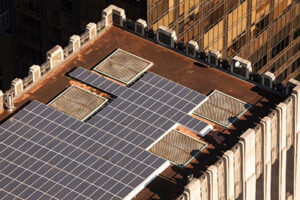 Launched in 2018, the LEED Zero certification is a relatively new designation in the building industry. To understand its meaning and implications, we should first examine the original LEED certification program. LEED certification has been a standard in the building industry since the 1990s. Environmentally conscious companies, architects and builders have sought to reduce the environmental impact of their facilities by building green. The U.S. Green Building Council (USGBC) is an independent non-profit organization that maintains a rating system called LEED (Leadership in Energy and Environmental Design). LEED is recognized worldwide as a symbol of sustainability achievement.
Launched in 2018, the LEED Zero certification is a relatively new designation in the building industry. To understand its meaning and implications, we should first examine the original LEED certification program. LEED certification has been a standard in the building industry since the 1990s. Environmentally conscious companies, architects and builders have sought to reduce the environmental impact of their facilities by building green. The U.S. Green Building Council (USGBC) is an independent non-profit organization that maintains a rating system called LEED (Leadership in Energy and Environmental Design). LEED is recognized worldwide as a symbol of sustainability achievement.
Why get a LEED certification?
Facilities interested in pursuing a LEED certification strive for greater use of environmentally friendly materials and measures. Examples include low-flow water systems, better ventilation systems and elimination of harmful chemicals and gases through the use of low VOC emitting carpets and paints. Following this framework translates into buildings that are safer and healthier for the people living and working in them.
How is LEED certification earned?
Projects are scored in five areas: sustainable sites, water efficiency, energy and atmosphere, materials and resources, and indoor environmental quality. Although the rating system has evolved over the years, the current point system used by the USGBC allows projects to earn one of four designations.
- Certified rating: 40-49 points.
- Silver rating: 50-59 points
- Gold rating: 60-79 points
- Platinum rating: 80 or more points.
 All types of builds can become LEED Certified. Projects range from single-family homes, multifamily homes, commercial buildings, schools, mixed-use neighborhoods or land development projects, communities, and cities. The scope of the project is not limited to new builds. Existing buildings that are undergoing new interior design and construction or projects that are making improvements in operations and maintenance are also eligible for LEED certification. The USGBC issues LEED recertification to any projects that have been previously certified and have met new goals.
All types of builds can become LEED Certified. Projects range from single-family homes, multifamily homes, commercial buildings, schools, mixed-use neighborhoods or land development projects, communities, and cities. The scope of the project is not limited to new builds. Existing buildings that are undergoing new interior design and construction or projects that are making improvements in operations and maintenance are also eligible for LEED certification. The USGBC issues LEED recertification to any projects that have been previously certified and have met new goals.
What does LEED Zero mean?
The LEED Zero certification takes things to a new level. The designation recognizes net-zero operation in energy, water, waste and carbon. Any project that has previously earned LEED for Design & Construction or LEED for Operations & Maintenance may apply for LEED Zero certification from the USGBC if they meet the requirements in one of the four areas and can provide twelve months of supporting data.
Energy– Must implement ultra-efficient energy management strategies and on-site renewable energy generation.
Water– Maintain a potable water use balance of zero. Water use is offset with alternative water plus water is returned to its original source through on-site treated wastewater.
Waste– Achieve TRUE Zero Waste certification at the platinum level. The goal is to eliminate solid waste from landfills and the environment.
Carbon– Involves an analysis of carbon emissions generated by building energy consumption and occupant transportation vs. carbon emissions avoided or offset.
LEED Zero certification encourages higher levels of environmental responsibility and sustainability.






